by Bruce Wells | Feb 23, 2024 | Petroleum Technology
Reversing an earlier ban, voters in Long Beach, California, in 1962 approved petroleum exploration in their harbor. Five major oil companies formed a company called THUMS and built four artificial islands to produce the oil.
California’s headline-making 1921 oil discovery at Signal Hill launched a drilling boom that transformed the quiet residential area. So many derricks sprouted it became known as “Porcupine Hill.”
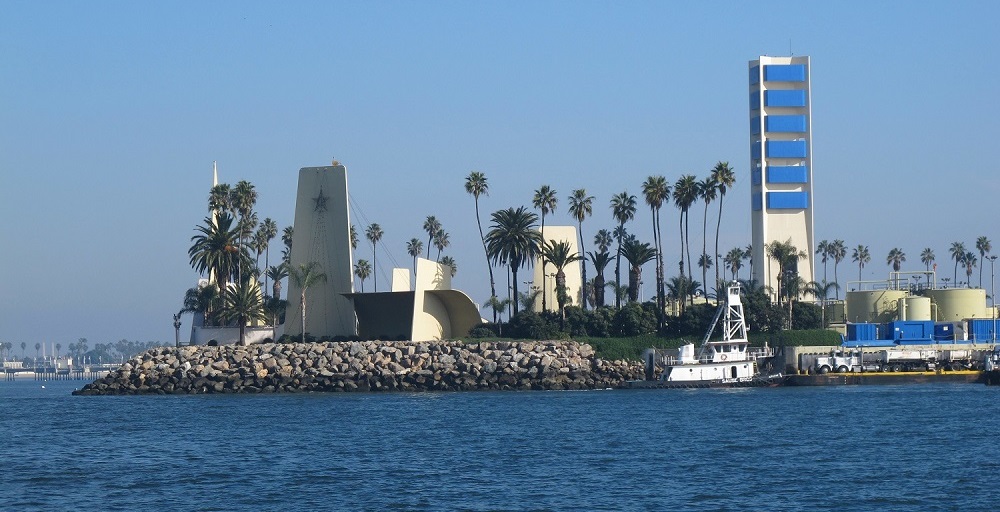
Island Grissom, one of the four THUMS islands at Long Beach, California, was named after NASA astronaut Col. Virgil “Gus” Grissom, who died in 1967 in the Apollo spacecraft fire. Photo courtesy U.S. Department of Energy.
With many homeowners aspiring to become drillers and oilfield speculators, much of Signal Hill’s land was sold and subdivided in real estate lots of a size described as “big enough to raise chickens.”
Derricks were so close to one cemetery that graves “generated royalty checks to next-of-kin when oil was drawn from beneath family plots,” noted one historian. Neighboring Long Beach joined the drilling boom.

By 1923, oil production reached more than one-quarter million barrels of oil per day. When Long Beach instituted a per-barrel oil tax, Signal Hill residents voted to incorporate in 1924.
At the time, “the law of capture” for petroleum production ensured the formerly scenic landscape would be transformed. Competing exploration and production companies crowded around newly completed wells and chased any signs of oil to the Pacific Ocean.

The islands are among the most innovative oilfield designs in the world. Circa 1965 illustration courtesy Oxy Petroleum.
By the early 1930s, the massive Wilmington oilfield extended through Long Beach as reservoir management concerns remained in the future. Naturally produced California oil seeps had led to many discoveries south of the 1892 Los Angeles City field.
Onshore and offshore tax revenues generated by production of more than one billion barrels of oil and one trillion cubic feet of natural gas helped underwrite much of the Los Angeles area’s economic growth. But not without consequences.
Long Beach: A Sinking City
The U.S. Army Corps of Engineers reported, “Subsidence, the sinking of the ground surface, is typically caused by extracting fluids from the subsurface.”

Petroleum reserves brought drilling booms to southern California. By 1923, oil production reached more than one-quarter million barrels of oil per day from Signal Hill, seen in the distance in this detail from a panorama from the Library of Congress.
Californians had a lot of experience dealing with groundwater induced subsidence and the building damage it caused, but by 1951, Long Beach was sinking at the alarming rate of about two feet each year.
Earth scientists noted that between 1928 and 1965, the community sank almost 30 feet. TIME magazine call the bustling port “America’s Sinking City.”

After decades of prospering from petroleum production, the city prohibited “offshore area” drilling to slow the subsidence as the community looked for a solution.
On February 27, 1962, Long Beach voters approved “controlled exploration and exploitation of the oil and gas reserves” underlying their harbor. The city’s charter had prohibited such drilling since a 1956 referendum. Advancements in oilfield technologies enabled Long Beach to stay afloat.
Directional drilling and water injection opened another 6,500 acres of the Wilmington field — and saved the sinking city.
THUMS: Texaco, Humble, Union and Shell
Five oil companies formed a Long Beach company called THUMS: Texaco (now Chevron), Humble (now ExxonMobil), Union Oil (now Chevron), Mobil (now ExxonMobil) and Shell Oil Company. They built four artificial islands at a cost of $22 million in 1965 (more than $200 in 2024 dollars).
The islands — named in 1967 Grissom, White, Chaffee, and Freemen in honor of lost NASA astronauts would include 42 acres for about 1,000 active wells producing 46,000 barrels of oil and 9 million cubic feet of natural gas a day.

The prospering but “sinking city” of Long Beach would solve its subsidence problem with four islands and advanced drilling and production technologies. Photo by Roger Coar, 1959, courtesy Long Beach Historical Society.
To counter subsidence, five 1,750-horsepower motors on White Island drive water injection pumps to offset extracted petroleum, sustain reservoir pressures, and extend oil recovery. The challenge was once described as “a massive Rubik’s Cube of oil pockets, fault blocks, fluid pressures and piping systems.”
Meanwhile, all of this happens amidst the scenic boating and tourist waters in Long Beach Harbor.
The California Resources Corporation operates the offshore part on the islands of the Wilmington field, the fourth-largest U.S. oilfield, according to the Los Angeles Association of Professional Landmen, whose members toured the facilities in November 2017.
Producing in Plain Sight
“Most interestingly, the islands were designed to blend in with the surrounding coastal environment,” explained LAAPL Education Chair Blake W.E. Barton of Signal Hill Petroleum.
“The drilling rigs and other above-ground equipment are camouflaged and sound-proofed with faux skyscraper skins and waterfalls,” Barton noted.
Most people simply do not realize the islands are petroleum production facilities. From the shore, the man-made islands appear occupied by upscale condos and lush vegetation. Many of the creative disguises came courtesy of Joseph Linesch, a pioneering designer who helped landscape Disneyland.

The THUMs islands required exceptional designs, and “the people who were involved at the time were very creative visionaries,” said Frank Komin, executive vice president for southern operations of the California Resources Corporation (CRC), owner of the islands.
About 80 percent of the company’s properties would overlie the Wilmington oilfield, according to CRC, noting that from 2003 to 2018, CRC operations generated over $5.2 billion in revenues, taxes and fees for the City of Long Beach and the state.
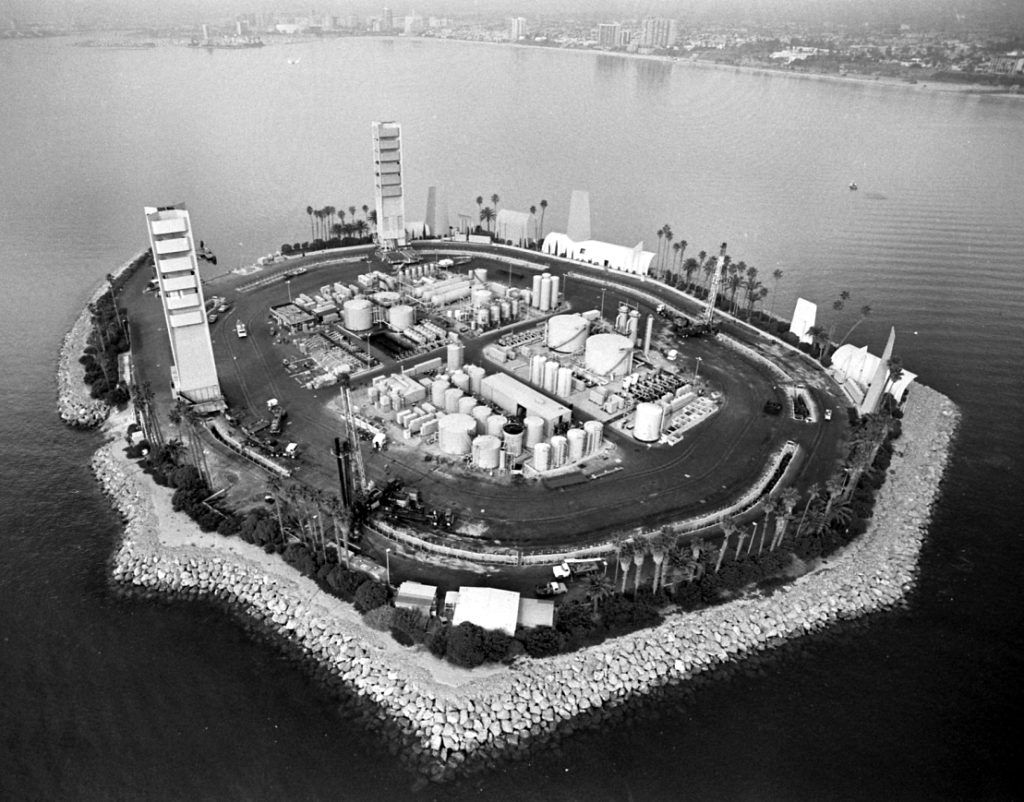
THUMS Island White, named for Col. Edward White II, the first American to walk in space, who died in 1967 along with NASA astronauts “Gus” Grissom and Roger B. Chaffee. A fourth island was named for NASA test pilot Ted Freeman, who in 1963 was the first fatality among the astronauts. Photo courtesy UCLA Library.
“Even today, those islands are viewed as one of the most innovative oil field designs in the world,” CRC executive Komin declared in a 2015 Long Beach Business Journal article. “The islands have grown to become icons in which the City of Long Beach takes a great deal of pride.”
The Journal explained that 640,000 tons of boulders, some as large as five tons, were mined and placed to build up the perimeters of the islands. “Concrete facades constructed for aesthetic purposes also divert industrial noise away from nearby residents,” the article added. For more noise abatement, electricity has provided nearly all the power for the islands.

The THUMS aesthetic integration of 175-foot derricks and production structures has been described by the Los Angeles Times as, “part Disney, part Jetsons, part Swiss Family Robinson.”
_______________________
Recommended Reading: An Ocean of Oil: A Century of Political Struggle over Petroleum Off the California Coast (1998); Black Gold in California: The Story of California Petroleum Industry  (2016); Early California Oil: A Photographic History, 1865-1940
(2016); Early California Oil: A Photographic History, 1865-1940 (1985). Your Amazon purchases benefit the American Oil & Gas Historical Society. As an Amazon Associate, AOGHS earns a commission from qualifying purchases.
(1985). Your Amazon purchases benefit the American Oil & Gas Historical Society. As an Amazon Associate, AOGHS earns a commission from qualifying purchases.
_______________________
The American Oil & Gas Historical Society (AOGHS) preserves U.S. petroleum history. Become an AOGHS annual supporting member and help maintain this energy education website and expand historical research. For more information, contact bawells@aoghs.org. Copyright © 2023 Bruce A. Wells. All rights reserved.
Citation Information – Article Title: “THUMS – California’s Hidden Oil Islands.” Authors: B.A. Wells and K.L. Wells. Website Name: American Oil & Gas Historical Society. URL: https://aoghs.org/technology/thums-california-hidden-oil-islands. Last Updated: February 23, 2024. Original Published Date: March 8, 2018.
by Bruce Wells | Sep 18, 2023 | This Week in Petroleum History
September 18, 1855 – First U.S. Oil Company reorganizes –
In need of more capital, George Bissell and partner Jonathan Eveleth reorganized their New York-based Pennsylvania Rock Oil Company — America’s first oil exploration company — into the Seneca Oil Company of New Haven, Connecticut. They continued to seek investors for drilling a well to produce oil that could be refined into kerosene.
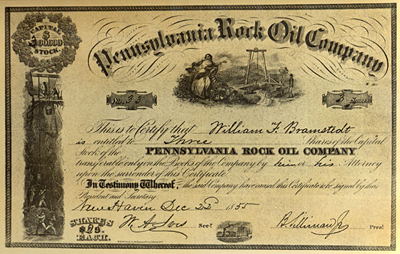
America’s first oil company, Pennsylvania Rock Oil Company, reorganized as Seneca Oil Company of New Haven Connecticut in 1858, one year before drilling the first U.S. Well.
The Pennsylvania Rock Oil Company had been established in 1854 to drill a well near Titusville (see George Bissell’s Oil Seeps). The re-incorporated business replaced New York City’s capital markets, which had shown little interest in drilling for oil, seen as too speculative.
Seneca Oil hired former railroad conductor Edwin L. Drake, who overcame financial and technical obstacles to complete the first U.S. oil well in August 1859.

September 18, 1948 – Oil discovered in Utah
J.L. “Mike” Dougan, president of the Equity Oil Company, completed Utah’s first significant oil well. Dougan’s small company outcompeted larger and better financed exploration companies, including Standard Oil of California (Socal), Pure Oil, Continental, and Union Oil. His Uinta Basin oilfield discovery launched a deep-drilling boom in Utah.
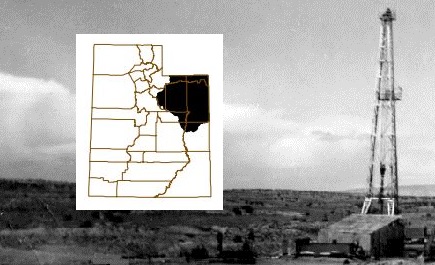
Begun in 1948 in the giant Uinta Basin, Utah’s petroleum industry continues today thanks to reserves of coalbed methane gas.
Unlike earlier attempts, Dougan drilled beyond the typical depth of up to 2,000 feet. His Ashley Valley No. 1 well, 10 miles southeast of Vernal, produced 300 barrels of oil a day from about 4,000 feet.
Uinta Basin production soon averaged almost one million barrels of oil a year from 30 wells. As drilling technologies advanced, companies began drilling to 8,000 feet and deeper.
Learn more in First Utah Oil Wells.
September 21, 1901 – First Louisiana Oil Well
Nine months after the headline-making January 1901 “Lucas Gusher” in Texas, another giant oilfield was revealed 90 miles east in Louisiana. W. Scott Heywood — already successful thanks to wells drilled at Spindletop Hill — completed a wildcat well that produced 7,000 barrels of oil a day well on the farm of Jules Clement.
Drilled six miles northeast of Jennings, the Clement No. 1 found oil at a depth of 1,700 feet. “The well flowed sand and oil for seven hours and covered Clement’s rice field with a lake of oil and sand, ruining several acres of rice,” noted the Jennings Daily News.

Mrs. Scott Heywood unveiled a marker as part of the Louisiana Golden Oil Jubilee in 1951. Times Picayune (New Orleans) image courtesy Calcasieu Parish Public Library.
The discovery led to the state’s first commercial oil production by opening the prolific Jennings field, which Haywood further developed by building pipelines and storage tanks. As the oilfield reached peak production of more than nine million barrels of oil in 1906, more discoveries arrived in northern Louisiana.
Learn more in First Louisiana Oil Wells.

September 22, 1955 – End of Signal Oil’s “The Whistler” Radio Program
Sponsored since 1942 by the largest independent oil company on the West Coast, the last episode of the radio drama “The Whistler” aired on CBS Radio. Signal Oil Company had been established in 1921 by Samuel Mosher as Signal Gasoline Company during California’s Signal Hill oil boom.
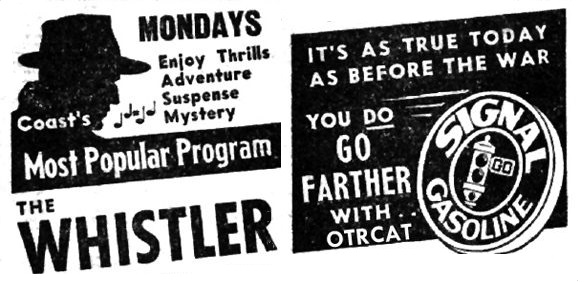
Signal Oil Company sponsored a CBS Radio mystery program beginning in 1942.
The company’s 1931 partnership with Standard Oil of California (Socal) led to sponsorship of many radio programs, according to Media Heritage. The 692 episodes of Signal Oil’s weekly radio mystery began with echoing footsteps and an eerie whistle, followed by “That Whistle is your signal for the Signal Oil program.”
September 23, 1918 – Giant Wood River Refinery goes Online
Roxana Petroleum Company’s Wood River (Illinois) facility began refining crude oil. It processed more than two million barrels of oil from Oklahoma oilfields in its first year of operation.
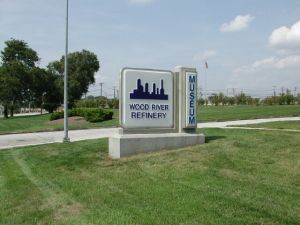
The Wood River Refinery History Museum is in front of the Phillips 66 Refinery southeast of Roxana, Illinois.
Roxana Petroleum Company was the 1912 creation of the Royal Dutch/Shell Group, which founded the American Gasoline Company in Seattle to distribute the fuel on the West Coast.
Roxana Petroleum was established in Oklahoma to produce high-quality oil to be refined at the Wood River plant. In West Texas, the company in 1928 built an experimental oil storage reservoir (see Million Barrel Museum).
Today, the Wood River 2,200-acre refinery at Roxana northeast of St. Louis is the largest owned by Phillips 66.
Visit the Wood River Refinery History Museum.

September 23, 1933 – Standard Oil of California Geologists visit Saudi Arabia
Invited by Saudi Arabian King Abdel Aziz, geologists from Standard Oil Company of California arrived at the Port of Jubail in the Persian Gulf. Searching the desert for petroleum and “kindred bituminous matter,” they discovered a giant oilfield. The Saudi Arabia and Standard Oil partnership would become the Arabian American Oil Company (Aramco), later joined by other major U.S. companies.
September 23, 1947 – New Patent for “Hortonspheres”
Horace E. Horton’s Chicago Bridge & Iron Company (CB&I) received a patent for improvements to a spherical storage vessel he had invented in the 1920s. Designed to efficiently store natural gas, butane, propane and other volatile petroleum products, the large spheres were among the most important storage innovations to come to the U.S. oil and natural gas industry.
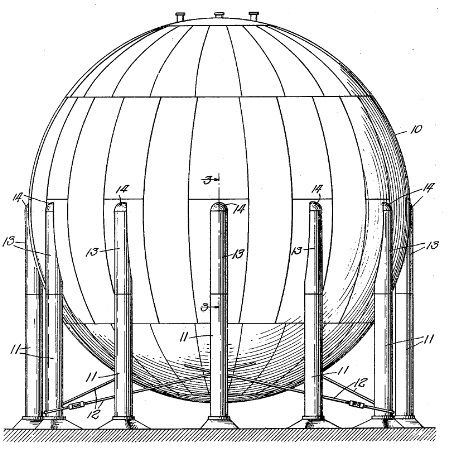
Horace Ebenezer Horton (1843-1912) founded the company that would build the world’s first “field-erected spherical pressure vessel.”
CB&I named its “Hortonspheres” after the engineer who had started the company in 1889 to build bridges across the Mississippi River. In 1892, CB&I erected its first elevated water tank in Fort Dodge, Iowa.
“The elevated steel plate tank was the first built with a full hemispherical bottom, one of the company’s first technical innovations,” CB&I noted, adding that company built, “the world’s first field-erected spherical pressure vessel” in 1923 at Port Arthur, Texas.
Learn more in Horace Horton’s Spheres.
September 24, 1951 – Perforating Wells with Bazooka Technology
When World War II veteran Henry Mohaupt applied to patent his “Shaped Charge Assembly and Gun,” he brought anti-tank technology to the petroleum industry — a downhole bazooka.
Mohaupt, a Swiss-born chemical engineer, during the war had conducted a secret U.S. Army program to develop an anti-tank weapon. His idea of using a conically hollowed out explosive charge to focus detonation energy led to the rocket grenade used in bazookas.

The patented “Shaped Charge Assembly and Gun” of Henry Mohaupt brought to the oil patch his highly successful anti-tank “bazooka” technology of World War II.
After the war, the potential of these downhole rocket grenades to facilitate flow from oil-bearing strata was recognized by the Well Explosives Company of Fort Worth, Texas. The company employed Mohaupt to develop new technologies for safely perforating cement casing and pipe.
Learn more in Downhole Bazooka.

_______________________
Recommended Reading: Myth, Legend, Reality – Edwin Laurentine Drake and the Early Oil Industry (2009); Utah Oil Shale: Science, Technology, and Policy Perspectives
(2009); Utah Oil Shale: Science, Technology, and Policy Perspectives (2016); Louisiana’s Oil Heritage, Images of America
(2016); Louisiana’s Oil Heritage, Images of America (2012); Signal Hill, California – Images of America
(2012); Signal Hill, California – Images of America (2006); Handbook of Petroleum Refining Processes
(2006); Handbook of Petroleum Refining Processes (2016); The Bazooka
(2016); The Bazooka (2012). Your Amazon purchase benefits the American Oil & Gas Historical Society. As an Amazon Associate, AOGHS earns a commission from qualifying purchases.
(2012). Your Amazon purchase benefits the American Oil & Gas Historical Society. As an Amazon Associate, AOGHS earns a commission from qualifying purchases.
_______________________
The American Oil & Gas Historical Society (AOGHS) preserves U.S. petroleum history. Become an AOGHS annual supporting member and help maintain this energy education website and expand historical research. For more information, contact bawells@aoghs.org. Copyright © 2023 Bruce A. Wells. All rights reserved.
by Bruce Wells | Mar 8, 2015 | Petroleum Companies
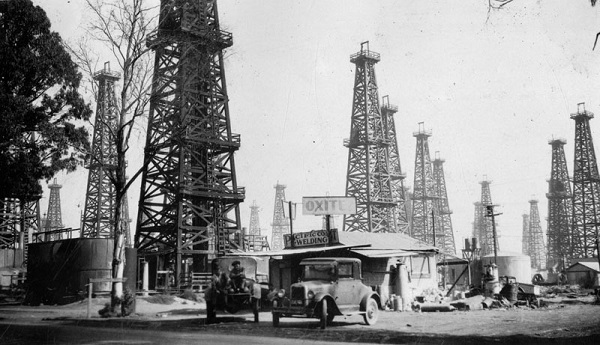
The Signal Hill oil discovery helped make California the source of one-quarter of the world’s entire oil output. “Porcupine Hill” was producing 260,000 barrels of oil a day by 1923 – and attracting a few shady characters.
In the summer of 1921, the Alamitos No. 1 oil exploratory well brought another spectacular California discovery – and the Signal Hill Oil Boom. As oil fever spreads, a wealthy real estate developer will take advantage of unwary investors.
Signal Hill soon became known as “Porcupine Hill” as exploration companies scrambled to the Long Beach field, 20 miles south of Los Angeles. By 1923, Long Beach was producing almost 260,000 barrels of oil every day. Investors looked for opportunities.
Successful Los Angeles real-estate developer John P. Mills formed his company in 1922. He incorporated it with three trusts and a charter for financing acquisition of properties in Long Beach and developing any oil and natural gas discovered on those properties. John P. Mills Company sold large numbers of $400 units over the next two years.
But there was no oil. Subsequent court documents would reveal it was ultimately “determined that the land was nonproductive of oil.” Then the struggle and litigation began.
The property was to be sold under the provisions of the trust agreement but with the consent of about 3,000 unit holders. The proceeds were to then be divided among the holders of the various units – but agreement proved impossible.
Although litigation and appeals dragged on until 1939, the John P. Mills Organization’s pursuit of oil had long since been abandoned. By then, Mills was far more notorious for his role in Los Angeles’ scandalous “Love Mart” affair of 1931 – in which local millionaires paid for underage girls, according to the Los Angeles Times.
Read more about California oil history in First California Oil Well, Discovering Los Angeles Oilfields and California Oil Seeps.
___________________________________________________________________________________
The stories of exploration and production companies joining petroleum booms (and avoiding busts) can be found updated in Is my Old Oil Stock worth Anything? The American Oil & Gas Historical Society preserves U.S. petroleum history. Please support this AOGHS.ORG energy education website. For membership information, contact bawells@aoghs.org. © 2018 Bruce A. Wells.





(2016); Early California Oil: A Photographic History, 1865-1940
(1985). Your Amazon purchases benefit the American Oil & Gas Historical Society. As an Amazon Associate, AOGHS earns a commission from qualifying purchases.










